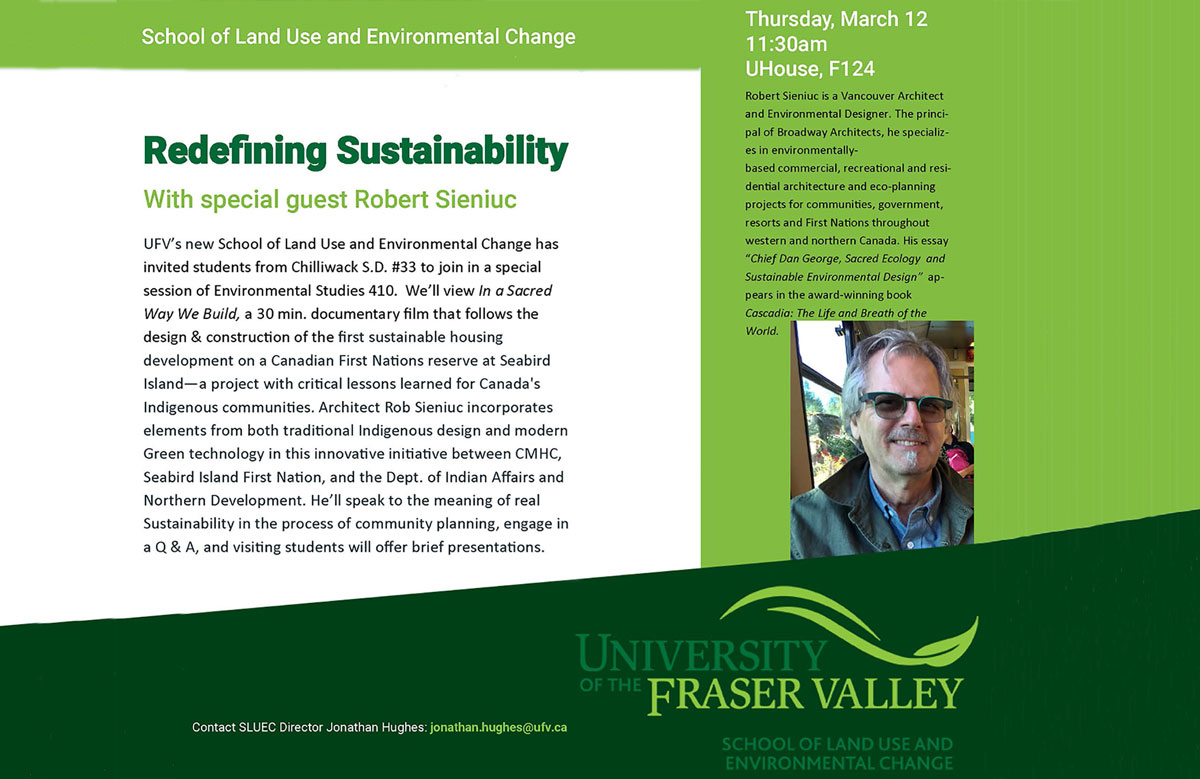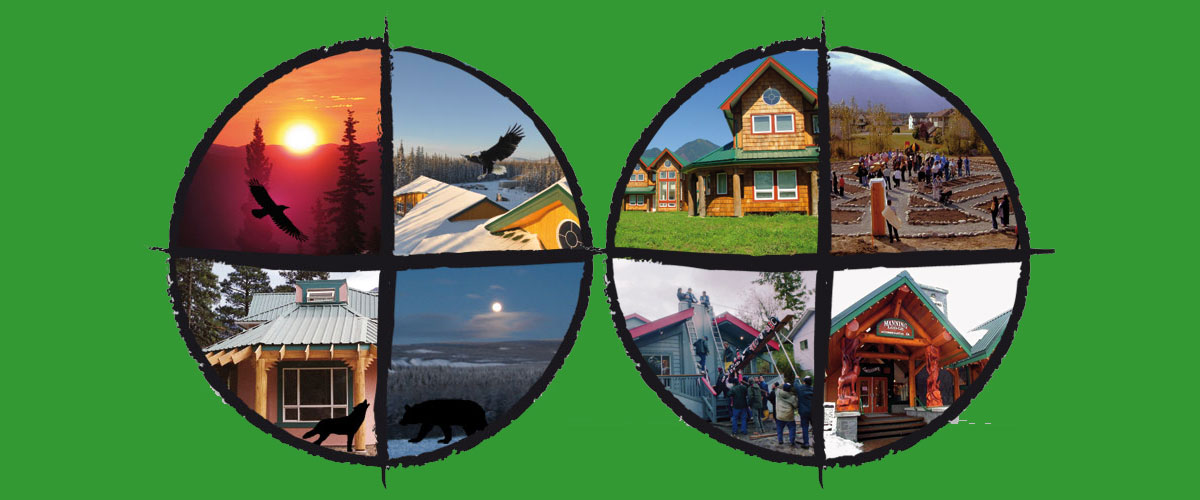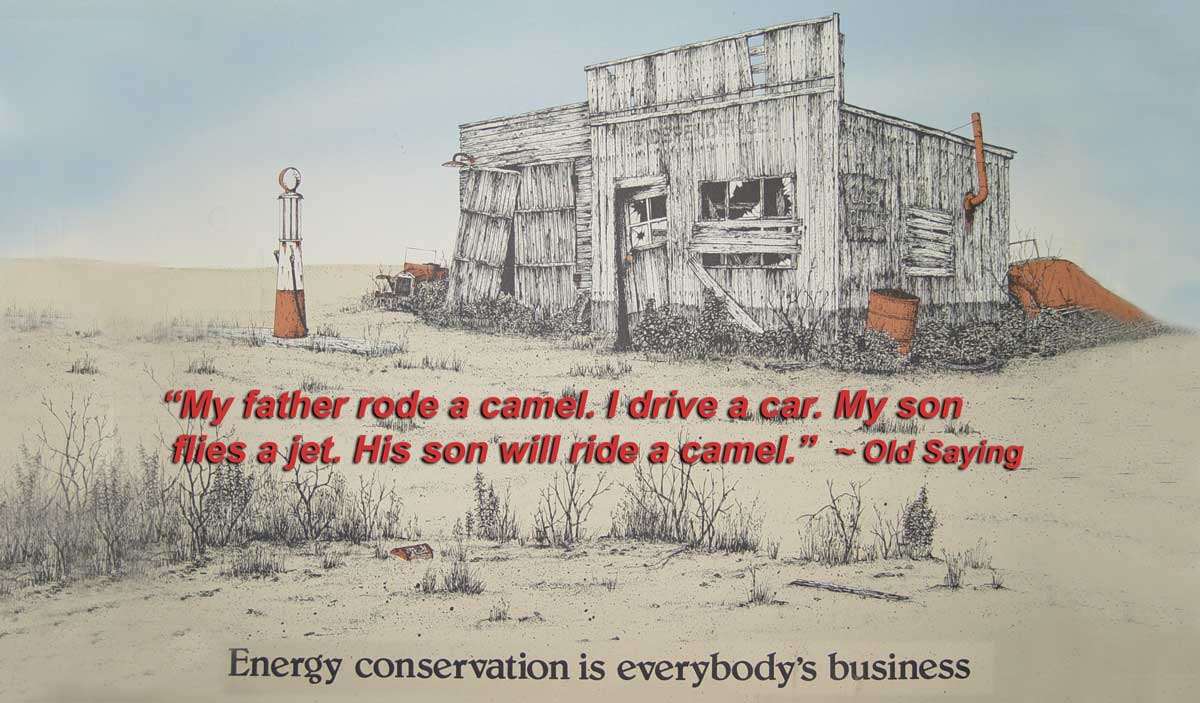REDEFINING SUSTAINABILITY (March 2020/updated January 2023)
Guest Lecture by Rob Sieniuc
University of the Fraser Valley, BC
"Sustainability is about living in balance on our planet—'In ECOlibrium' with the natural world within nature’s limits.”
~ Rob Sieniuc, Broadway Architects
What is Sustainability?
"To sustain—keep in existence, to maintain"
Unfortunately, the word sustainability is misused and overused. Today everything is talked about as being "sustainable" to characterize it to the public as earth friendly—from not only green architecture but to health care and even mining—which implies that minerals are a renewable resource, which as we all know is not true.
The term has been hijacked by industry. It has become a marketing mantra for business to greenwash their products whether deserved or not. Today, advertisers use it to indiscriminately describe everything from cars, to condos to shampoo. An astounding 42% of global business websites randomly reviewed by the International Consumer Protection Enforcement Network, advertised false, exaggerated or deceptive environmental claims on their company websites—with 59% of the sites not providing evidence to support their claims. Even the United Nations definition of sustainability (first outlined in 1987) as a tripartite, equal relationship between the environmental, social and economic realms is problematic—as it grossly under estimates the role that "nature" plays.
REDEFINING SUSTAINABILITY in my view must speak to the importance of "living in balance" on our planet—"In ECOlibrium” with the natural world within nature’s limits”.
There is an ageless planning concept—community planning that respects the "environmental carrying capacity" of an area—the land’s ability to maintain and regenerate (keep in existence), and acknowledges the adverse consequences in building beyond that. In redefining sustainability (sustainable development), I prefer the term “Environmental Design” rather than "sustainability” as it is more encompassing—it recognizes the importance of the environment, and the role of communities in the way we plan, build and develop. It acknowledges our temporary stewardship of the planet and the important inter-relationships that are essential to maintaining clean air, soil, water, and the environments that sustain life.
Environmental design starts with the land and embraces the local community to sensitively accommodate our built environments. Land, people and animals, buildings—that is the order. The philosopher Krishnamurti taught that nature was an integral part of our being: if we hurt nature, we hurt ourselves. British Columbia's own Chief Dan George spoke of our being part of the greater Mother Earth and the interdependence of everything and that we need to return to the land with a spiritual perspective.
Many of us have had homesteading grandparents who had direct connections to the land and relied on it for sustenance. They lived by the cycles of nature — planting and harvesting in tune with the seasons. Today, we live mostly indoors, in climate-controlled buildings isolated from the natural world—in an instant on-off culture where we can flick a light switch, or remotely turn on the heat, lights or a TV and stereo all at our whim — in buildings that keep us isolated from nature. Our buildings have come to be situated across vast tracts of land, without regard for how they alter the flow of rain to the water table, disturb wildlife habitat, and consume materials and fuel in their construction and maintenance.
Not that long ago in 1900 only 10% of our population lived in urban centres. In 2023 that number is close to 60%. That’s a large number of people living in cities with many out of touch with the natural rhythms of the planet.
In North America there are over 165 million buildings—148 million of which are housing (single family homes or multi units). Collectively, they consume a significant amount of our energy and the majority of the world’s natural resources, and contribute most of the waste in our landfills. Almost half of all greenhouse gas emissions are traceable to our human created environments. But most significantly, of all the world’s buildings stock, 80% (2.3 billion) are single family homes or lowrise multi-family unit housing. That is where the biggest gains can be made in addressing our climate emergency.
What are our options?
Successful environmental design compels all of us to rediscover the ecological interconnectedness our grandparents and indigenous cultures traditionally had with their environments. This means we need to build projects, particularly housing, that benefit directly from the sun’s and earth’s passive energy.
That is community scale development based on low technology applications, such as passive-solar and earth-tubes for heating, that incorporate for example natural ventilation and more effective use of natural daylight, rather than energy intensive mechanical systems, and use less land and support local food production.
Our Seabird Island Sustainable Community Demonstration project was an early proponent addressing sustainability. The lessons learned still apply. I have worked with many other communities and small resorts in the years since particularly in the far north where the weather is extreme and affects of climate change are most pronounced. Buildings here have to be designed as super-green, energy-efficient facilities with double walls, triple and quad glazed windows, many with heavy timber and standard wood framing, earth tubes and geo exchange. Wood—the only major renewable, carbon-neutral building material—is used extensively in constructing these facilities. Such choices result in substantial reductions in greenhouse gas emissions and energy costs.
The world population is approximately 7.9 billion. It now takes the Earth over 18 months to regenerate the natural resources that we use in a year to support this population.” To address this we need to create a way of living that is based on less economic growth, personal consumption, and waste. That is why it makes sense to build energy-efficient, environmentally respectful communities that are powered by alternative sources of energy—sun, earth, wind, water.
How do we get there?
In redefining sustainability, I believe the answer is in our local community. Pete Seger used to say that “Participation—that's what's gonna save the human race.” Not government, not politicians or corporations but our own community. Why?— because ecological awareness is native to place. This is especially true when applied to the resource industries where there is usually no direct community connection with the company to the place where they operate and thereby no perceived overiding environmental community responsibility.
Sometimes, preserving the delicate carrying capacity of a particular place—means saying ‘no’. Engaged communities understand this as a necessary part of stewardship. In so doing, we will recognize in our redefining of sustainability that it is nature that overrides all—not economics. True sustainable design puts the health of nature’s eco systems above all else.
As Chief Dan George reminded us, “We are as much alive as we keep the earth alive".
What do we need to do to live more sustainable?
-
- Create smaller footprints, smarter buildings. In the sixties a typical family lived in a 1,000 sf house. In the 80’s that became 2,000 sf. Today its over 3,000 sf
- Build energy efficient projects that benefit directly from the sun’s and earth’s passive energy
- Put a focus on housing—it can contribute the most in addressing ecological issues
- Greater use of carbon neutral wood products—the only major renewable building product
- Greater use of all available alternate energy sources—sun, wind, water, earth energy
- Use low-technology applications—passive solar, earth tubes. Technology has to remain simple, and accessible at the community level
- Use more natural systems: natural ventilation / day lighting / passive heating rather than high energy intense mechanical systems
At the local community level:
-
- Successful environmental design is achieved when communities are actively involved in their own planning, design and construction processes. This includes self-building to maximize local resources, materials and labour, and minimize waste.
- Support community-based development based on efficient use of the land
You can’t have good building and developments without good planning - Identify, protect, preserve sensitive lands from development and rehabilitate lands wherever possible
- Commit to “Living Small as the New Large ”—be mindful of our own personal impact on the environment in order to lower carbon emissions
- Support, practice urban gardening (edible landscapes) and conservation— local food production lessons transportation impacts
- Put the ECO back in ECOnomics—Buy Less, Use Less
- Support and encourage local knowledge of an area in community planning and decision making

Rob Sieniuc, M.E. Des. (Architecture), BA, AIBC
Principal, Broadway Architects (Rob Sieniuc + Associates)
Architects & Environmental Designers Vancouver, BC, Canada




